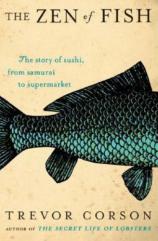Excerpt
Excerpt
The Zen of Fish: The Story of Sushi, From Samurai to Supermarket

Chapter 9. “Hollywood Showdown”
On the morning of the Hollywood party at Paramount Pictures, Toshi
arrived at the restaurant well ahead of his staff. By 10:00 a.m. he
was hard at work in the kitchen. The party would begin in eight
hours.
Toshi stood at a stainless-steel table that would look at home in a
morgue. The table was 12 feet long and ran diagonally across the
kitchen. On its surface was a cutting board of high-density
polyethylene, chemically fused to repel bacteria, fat, and blood,
but soft enough that Toshi could wield his high-carbon blade for
several hours without dulling its razor-sharp edge.
Toshi bent over a big block of blood-red flesh. When sushi first
became popular in the early 1800s, a high-class chef like Toshi
would have been run out of town for serving tuna. The bloody meat
of fresh tuna and other red-fleshed fish spoils easily and the
Japanese considered it smelly. The fatty belly meat of the tuna was
especially despised. But with the advent of refrigeration, the fish
could be kept fresh, and in the years after World War II the
Japanese learned from Americans to love red meat, including
tuna.
Takumi, the Japanese student, stood across the table and watched.
On his cutting board sat a similar but smaller slab of tuna.
Toshi carved through the block of flesh like a sculptor,
scrutinizing the muscle, turning and trimming. He tossed scraps
into a bowl.
“We’ll use these for spicy tuna,” he said. He was
speaking Japanese, but the words “spicy tuna” were in
English. There isn’t even a name for it in Japanese. In the
early days of American sushi, Japanese chefs in L.A. had realized
they could take the worst parts of the fish—the fibrous
scraps, the flesh left on the skin, and meat past its
prime—and chop them up with chili sauce. The taste of the
fish was lost, but Americans loved it.
“The Mexican influence here is strong,” Toshi told
Takumi. “Americans like spicy food more than Japanese people
do.”
Takumi nodded. In a few minutes, he would scrape shreds of meat off
the skin with a spoon, chop them up with the other scraps, and
squirt the mixture full of hot sauce. But now he tried his hand at
trimming his slab of tuna. When he started to cut, Toshi stopped
him.
“No, not like that. You’re cutting in the same
direction as the fiber.” With his finger Toshi traced the
parallel lines of connective tissue that ran through the
tuna’s flesh like the grain in a piece of wood. “See?
You’ve got to cut against the fiber.” Toshi flipped the
slab of meat over, so Takumi could slice into it from the other
side. “Cut them thinner than you would for the
restaurant,” he added. “For a catering job like this,
we go for volume.”
Other restaurant staff trickled in to help prepare for the party.
Toshi’s office assistant dumped a two-pound bag of bright
green powder labeled “wasabi” into a mixing bowl. Like
most wasabi served in restaurants, there wasn’t a shred of
wasabi in it. Real wasabi is a rare plant that is notoriously
difficult to grow, and tastes quite different. This was a mix of
horseradish and mustard powder. She added water and stirred. The
powder jelled into a green blob, which emitted fumes. Toshi
wheezed.
“Get the hell out of the kitchen with that thing!” he
bellowed. “It’s going to drive us all
crazy.”
The woman bowed, hugged the bowl to her chest, and left, her eyes
watering.
Soon Kate and the other students trickled in and loaded the
catering equipment into a rented truck. Jay shouted out
instructions.
“Bring a minimal amount of stuff with you!” Jay said.
“Do not bring big bags! Otherwise, you’re not going to
get through security!”
But of course, they took their knives.
The students would ride in the restaurant’s old van. Kate
hopped into the front passenger seat and pulled the door shut with
a bang. They cruised down the freeway. In the distance the glass
towers of downtown L.A. rose through the haze. Soon they were
driving straight toward the gigantic white “HOLLYWOOD”
letters on the hill. They pulled alongside a vast, high-walled
compound. Security cameras monitored the van’s arrival.
At the security checkpoint there were men with guns—big guns.
Some rested Winchester rifles on their shoulders. Others carried
six-shooters on their hips. Most of them wore ten-gallon hats and
chaps. They were actors. The real guards wore windbreakers and
carried walkie-talkies. The actors passed their guns to the guards
and walked through the metal detector. When the guards saw
Kate’s chef’s jacket, they found her name on a list and
waved her through, along with her case of knives.
Inside the compound Kate followed her classmates past a row of
hangars and emerged onto the edge of an American frontier town of a
hundred years ago, bustling with inhabitants of the Old West. The
sushi students wandered into the town like a gang of lost samurai.
Around them cowboys twirled lassos. The smell of grilled beef
swirled through the streets.
The town continued for blocks. In the distance a pointy white water
tower perched on stilts. Painted on its side was a snowy mountain
under the word “Paramount.” Kate shambled through the
streets clutching her knife case. Ahead she saw Toshi and some of
the staff setting up their sushi stall on a street corner.
• • •
More than sixty restaurants would be hawking food from colorful
stalls—most of it seared or baked or fried, all of it
smelling delicious. Some of those restaurants were legends.
Pink’s and its “famous hot dogs” had started in
the 1930s. The stall beside the sushi stall was belching smoke. It
was called “The Pig.” When Toshi found a chance to slip
away for a few minutes, he’d make a beeline for Lawry’s
roast beef.
Now he buttoned up his chef’s jacket and surveyed the
equipment—the 25-gallon coolers filled with fish, the
insulated containers of rice, the cases of knives, the soy-sauce
bottles, the blocks of disposable chopsticks.
Then he surveyed the students. Some were helping set up, but others
stood around, not sure what to do. His eye lingered on Kate.
“We need backup,” he said to himself.
Toshi rooted in the pile of equipment for his secret
weapon—the Suzumo SSG-GTO. He located the black padded case
and carried it to the back of the stall.
The Suzumo SSG-GTO looked like a wooden tub with a lid. Sushi chefs
had been keeping rice in wooden tubs for nearly 200 years. This tub
was different. Toshi tugged an electrical cord out of the back and
searched for an outlet. He froze. This was the Old West. There were
no outlets.
Toshi scowled and scanned the street for a grip. He’d been
around Hollywood long enough to know that anywhere movies were made
there was electricity. You just needed a grip to show you where it
was. He spotted a man bristling with tools, gadgets, and brackets
hanging off belts. Toshi dragged the fellow over to the sushi
stall. The grip knelt and unscrewed a steel plate in the ground.
Inside was an array of heavy-duty sockets. Toshi powered up the
GTO.
Like the town around him, the wood on Toshi’s wooden tub was
fake. He lifted off the plastic lid and dumped in cooked rice. He
pressed a button. A drawer slid out. He typed instructions on a
keypad and the GTO hummed to life.
Toshi’s wife and children had arrived. His son Daisuke rushed
over to the GTO. The Japanese student, Takumi, joined them and the
three of them leaned over the machine, hands on their knees, and
peered inside.
Like the robots that build cars in the factories of Toyota and
Honda, sushi-making robots have become commonplace in Japan,
laboring tirelessly behind the scenes at mass-market sushi
establishments. In Europe, owners of conveyor-belt sushi
restaurants have been known to install elaborate, stainless-steel
sushi robots in plain view, where customers admire their high-tech
wizardry. But in the U.S., sushi robots are a well-kept secret.
Most restaurant owners keep them out of sight, and use them for
takeout and delivery orders.
Toshi pressed a button on the GTO. Gears clicked and motors
whirred. The GTO could crank out professional-grade rectangles of
pressed sushi rice at speeds approaching 1,800 per hour. But it
jammed. Toshi cursed.
“It’s not working!”
The Zen of Fish: The Story of Sushi, From Samurai to Supermarket
- hardcover: 384 pages
- Publisher: HarperCollins
- ISBN-10: 0060883502
- ISBN-13: 9780060883508




